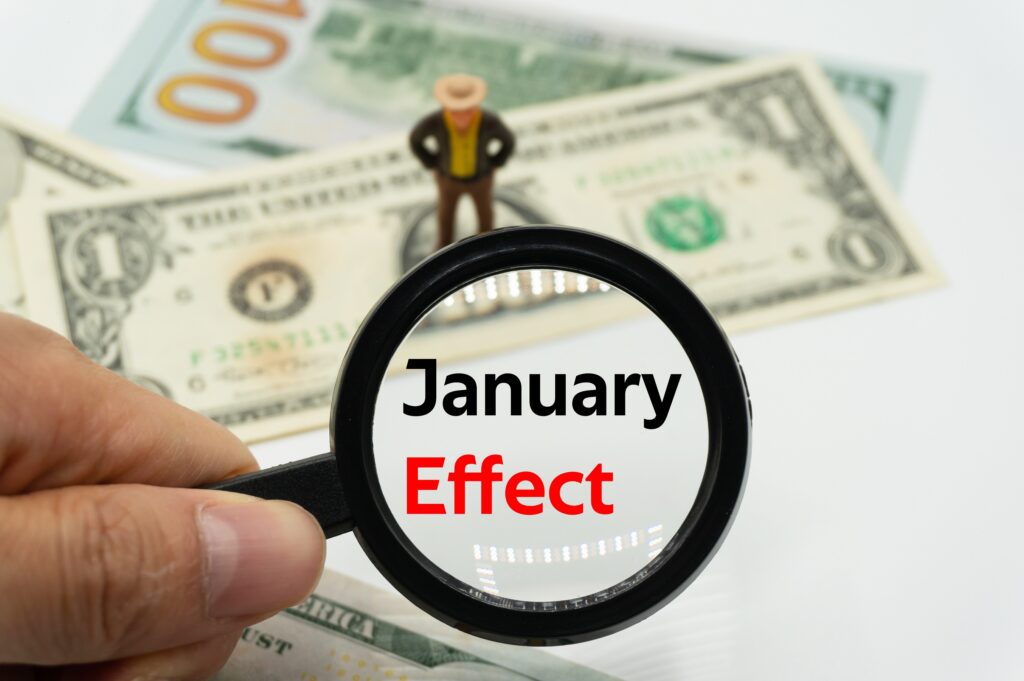
You may have heard of “the January Effect.” It refers to the belief that stock prices tend to rise more in January than in any other month.
Some traders believe the January Effect is a reliable “calendar effect” that can enable them to purchase stocks at a low price and then sell them after the January Effect has taken place and prices have increased.
How the Theory Came to Be
Investment broker Sidney Wachtel first noticed the “January Effect” in 1942. As he analyzed market returns dating back to 1925, he saw that stocks tended to see greater gains in January than in other months. Later on, a variety of academics confirmed this trend. This pattern has been observed in various stock markets around the world, including the United States.
There are many theories about why the January Effect occurs. Here are just four of many:
- Some believe the January Effect is the result of smaller stocks outperforming larger stocks at the start of the year.
- Another theory is that the rebalancing of portfolios and tax-loss selling at the end of the previous year can lead to increased demand for stocks when people rebuy in January.
- A third theory is that some investors may be more optimistic about the market at the beginning of the year, which could contribute to the increase in stock prices.
- Still another belief is that the January Effect is caused by people getting year-end bonuses and investing them in the market, or by end-of-year contributions to employee pensions and 401(k) plans.
Is It Fact or Fiction…Or Some of Both?
It appears that there have been some confirmed cases of the January Effect actually taking place. However, there is no clear consensus that the January Effect is a reliable hypothesis, and it certainly isn’t true on a consistent basis. Some studies have confirmed it has been documented primarily in the small-cap world, but the same studies found that the effect has decreased in magnitude over time. In January 2022, The Wall Street Journal reported that this theory applies to bonds more than to stocks.
Analysts at Investopedia ran some numbers to find out if there is any credence to the January Effect. They found that since the start of the 2009 market rally through January 2022, January months showed eight winners vs. six losers, a split of 57 percent to 43 percent. Given the strong rally from 2009, we might expect a higher number of January winners, but that is not the case.
You’ve probably heard the saying, “If it’s so easy, everyone would be doing it.” We believe that’s the case here. If, in fact, if there are always strong returns in January, then why isn’t everyone taking advantage of this phenomenon?
As with many “arbitrage opportunities,” the devil is in the details. (Arbitrage simply means taking advantage of price differences across markets — buying a cheaper version and then selling it at a higher price to make money.) Even when the January Effect does appear, it does not produce additional returns when accounting for risk. The same is true for other calendar-based trading strategies.
To put it simply, most anomalies, especially those based on relatively simple trading strategies, have been exploited over time. While the market is not perfectly efficient, given the evolution of digital and low-cost trading, abnormalities are easily arbitraged away — or never really existed in the first place. This has been increasingly the case for the January Effect.
In our view, the January Effect is mostly fiction, with an occasional instance of truth — just enough to make people believe it’s a given!
Focus Instead on Your Family and Your Personal Goals
As always, and as we’ve maintained over the past 30 years, we do not believe markets can be timed — especially with very short-term trading strategies. There’s a lack of evidence, especially modern evidence, to suggest that retail investors can benefit from short-term trading around the January Effect or any other time.
We believe this time of year is better spent on many other, more important aspects of life, including spending time with friends and family, rather than looking at your portfolio. If you insist on looking at your portfolio, we encourage you to focus on the long term and to judge your success by your ability to do what you want today and in the future.
Regardless of what happens in any given month, there’s plenty of evidence to suggest that buying and holding great companies over the long term is one of the most effective ways to achieve your financial goals. We are here to review and update your planning and portfolio, adjust your asset allocation, minimize tax implications and take advantage of market volatility for you.
As always, we are here for you…
________
Randy Carver, CRPC®, CDFA®, is the president and founder of Carver Financial Services, Inc., and is also a registered principal with Raymond James Financial Services, Inc. Randy has more than 32 years of experience in the financial services business. Carver Financial Services, Inc,. was established in 1990 and is one of the largest independent financial services offices in the country, managing $2.2 billion in assets for clients globally, as of December 2021. Randy and his team work with individuals who are in financial transition as a result of divorce, retirement or the sale of a business. You may reach Randy at randy.carver@raymondjames.com.
The information contained in this post does not purport to be a complete description of the securities, markets or developments referred to in this material. The information has been obtained from sources considered to be reliable, but we do not guarantee that the foregoing material is accurate or complete. Any information is not a complete summary or statement of all available data necessary for making an investment decision and does not constitute a recommendation. Any opinions are those of Randy Carver and not necessarily those of RJFS or Raymond James. Expressions of opinion are as of this date and are subject to change without notice.
Returns are based on the S&P 500 Total Return Index, an unmanaged, capitalization-weighted index that measures the performance of 500 large capitalization domestic stocks representing all major industries. Indices do not include fees or operating expenses and are not available for actual investment. The hypothetical performance calculations are shown for illustrative purposes only and are not meant to be representative of actual results while investing over the time periods shown. The hypothetical performance calculations are shown gross of fees. If fees were included, returns would be lower. Hypothetical performance returns reflect the reinvestment of all dividends. The hypothetical performance results have certain inherent limitations. Unlike an actual performance record, they do not reflect actual trading, liquidity constraints, fees and other costs.
Also, because the trades have not actually been executed, the results may have under- or overcompensated for the impact of certain market factors such as lack of liquidity. Simulated trading programs in general are also subject to the fact that they are designed with the benefit of hindsight. Returns will fluctuate and an investment upon redemption may be worth more or less than its original value. Past performance is not indicative of future returns. An individual cannot invest directly in an index.

 10 Questions to Ask when Choosing a Financial Advisor
10 Questions to Ask when Choosing a Financial Advisor











